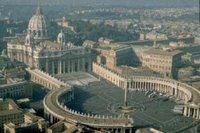
Scuole. Servizi. Ici. Radio. Parrocchie. Ecco tutti i privilegi che lo Stato
italiano riserva alla Chiesa
Il più noto è l'8 per mille più antico, l' extraterritorialità , garantita
a tutte le proprietà della Santa Sede fuori dalle mura vaticane. I privilegi
della Chiesa, codificati specie nei due Patti lateranensi, il Trattato e il
Concordato, si nascondono più spesso tra le pieghe delle Finanziarie e nel
corpus della normativa di casa nostra.
Non tutti sanno che la manovra 2005 finanzia con 15 milioni il Centro San
Raffaele del Mount Tabor Don Luigi Verzè. Or that the same law sets a one million funding for "upgrading the technology used in the field of radio, but restrict it to two channels: Radio Padania Libera , the radio of the Northern League, and Radio Maria .
Since 1985, the ' 8 per thousand tax on personal income tax is "designed for the purpose of a religious nature to the direct management of the Catholic Church" since 1929, is Italy to pay the 5 million cubic meters of water consumed on average each year by the Papal State. For waste water, Vatican City fastens ACEA, but not pay the bills .
When the company publicly traded in '99, the 44 billion pounds of debt them shelves, Ministry of Economy. Since then, the approximately 4 billion pounds year should be met by the Church . The Finance
2004 solves the case: allocates 25 million immediately and four e. or 2005 to give the Vatican a system of water right. The same maneuver provides 50 million in two tranches for the 'Campus Bio-Medico University , "apostolic work of Opus Gods. "
In 2003, Parliament had already recognized as equalized the Institute of Policy Studies of St. Pius V, approving the annual funding of 1.5 million . It is the year that passes the Law on the speakers: the state recognizes the educational and social centers of parish activities and finances. The record for 2005 is for the parish of Our Tuglie (Lecce): one million and € 180 000 for a soccer field, a bowling green, changing rooms and toilets.
Municipalities are obliged to pay 8 percent of charges for secondary infrastructure (kindergartens, schools, sports facilities district) to the churches. As for
Catholic schools, most of which are private, receive state subsidies in the form of contributions to the management (at just less than 500 million in 2005), funding of projects for "the elevation quality and effectiveness of training opportunities "( one million for the" training of managerial staff of the officially recognized "), for contributions to their families.
Chosen by CEI, but paid by the State , religion teachers were placed in a role with the 2003 law.
Finally, ICI: The exemption for the property, even intended for commercial use , owned by the Catholic Church became law in 2005.
Adapted from L'Espresso 12.01.2006
0 comments:
Post a Comment